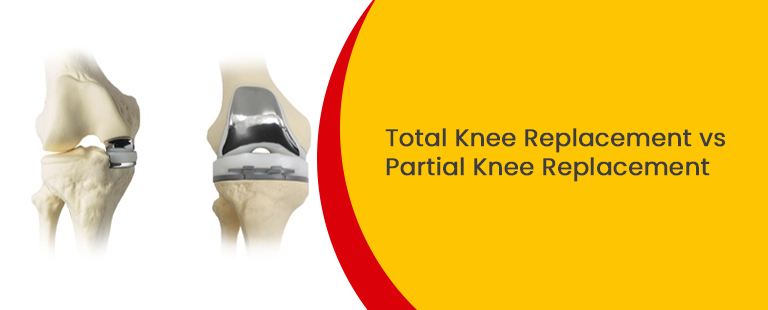Total Knee Replacement vs Partial Knee Replacement
Partial knee replacement or a total knee replacement will help you get back to a pain-free life. Let’s understand the pros and cons of a total knee replacement and partial knee replacement
What is Total Knee Replacement?
Also known as arthroplasty, total knee replacement is one of the most commonly performed surgeries in the world. This procedure is performed to reduce disability and pain generally caused by osteoarthritis, a form of degenerative knee arthritis. Physical therapy and other treatments may be performed but when these aren’t sufficient any longer, a knee replacement procedure may be recommended. This condition mainly affects people between the age of 50 to 80 years old.
Meniscus tears, rheumatoid arthritis, and cartilage defects are also a few reasons responsible for unbearable pain in the knee. In the total knee replacement procedure, the whole knee is replaced. The diseased surfaces are removed by the doctor, and the knee joint is resurfaced using a knee prosthesis, made up of plastic and metal.
What is Partial Knee Replacement?
When there is knee damage restricted to a certain area in the knee, then partial knee replacement could be an alternative to total knee replacement, for such candidates. Usually, the inner side of the knee is damaged in the primary stages of osteoarthritis. In this procedure, only the area of the knee cartilage that is diseased is replaced with a knee prosthesis and most of the joint cartilage, as well as the ligaments, are left intact. There isn’t any requirement of replacing the whole knee.
Partial vs Total Knee Replacement
Whether a patient should get partial knee replacement or total knee replacement is determined by the condition of the three knee compartments – the lateral compartment, the medial compartment, and the patellofemoral compartment. A total knee replacement would be done when two of the three compartments are diseased due to arthritis.
A partial knee replacement surgery, also known as unicompartmental knee surgery, may be more beneficial in the sense that there are fewer complications. The range of motion recovery is also quicker with this surgery as compared to total knee replacement surgery. It is minimally invasive and it might stop the disease from spreading further, diminishing the need for a total knee replacement surgery. The hospital stay post-surgery is less as compared to total knee replacement surgery and a higher number of patients can engage in low-impact sports, after minimally invasive partial knee replacement surgery.
There are also a few risks associated with partial knee replacement surgery such as a higher rate of revision or redoing the surgery, which can be more complicated as compared to prior surgeries.
At Germanten Hospital in Hyderabad, the total and partial knee replacement surgery is performed with the ‘0’ technique. Thanks to advanced medical technology, patients at our hospital don’t undergo post-surgery traumatic pain. The team of the best knee replacement doctors at Germanten Hospital is led by Dr Mir Jawad Zar Khan, a veteran of two decades in orthopedics. He is known for introducing newer, minimally-invasive surgical techniques and has experience of over 10000 knee replacement surgeries.
Dr Mir Jawad Khan introduced robot-assisted and computer navigation surgery for knee joint replacement to India. The robotic arm is extremely precise. It can cut to the nearest half millimeter. With the use of this technology, the installation of the knee prosthesis becomes less painful and safer.
The team of doctors at Germanten Hospital scans and models the patient’s knee in 3D, using this technology. This helps them determine the size of the implant, tailored to each different patient. Our surgeons obtain real-time information during the surgery, by installing sensors on the knee. This also helps them observe the retraction of tissues.
At Germanten Hospital, knee replacement surgery is performed within 25 minutes and the amount of blood loss is minimal due to fewer incisions. It is a completely painless procedure and our patients work with an experienced team of physiotherapists, post-surgery. For such pioneering work, Germanten Hospital has been graded as the Best Emerging Orthopaedic Hospital in India by the Times of India, in 2019. It has also been named the Best Orthopaedic Hospital in South India by the Economic Times in 2021. The hospital is NABH accredited, has over 200 beds, and state-of-the-art class 100 laminar operation theatres for total infection control.
Dr Mir Jawad Zar Khan’s exceptional work in the field of robotic knee replacement and other orthopedic surgeries has led Germanten Hospital to be known as the number one hospital for orthopedic surgery in India. A gold medalist of Osmania University, Hyderabad, he has been awarded the title of Best Doctor by the ex-CM of Joint Andhra Pradesh & Former Governor Tamilnadu, Shri Roshaiah Garu in 2018. He has also been felicitated with the Vaida Ratna Award by the Honorable Health Minister of Telangana, Shree Etala Rajendra in 2019. He has advanced training in the orthopedics field from Germany and the USA. Germanten Hospital is your one-stop solution for any knee pain.



